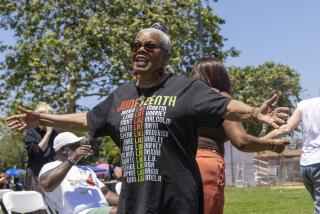Four children’s books introduce African American experiences
Picture books are often the primary means through which young children in the United States first learn about our nation’s history. Telling stories about traumatic past events can prove challenging, though. How can we inspire young people from all backgrounds while being honest about the pain and the hope of the African American story?
Taking up this charge, four new picture books by award-winning authors and illustrators introduce slavery, Reconstruction, the Harlem Renaissance, and the civil rights movement to a new generation.
Set in Huntsville, Ala., during the 1960s, Hester Bass’ “Seeds of Freedom” (Candlewick: 32 pp., $16.99, ages 5-8) begins by contrasting future possibilities with past injustices: “As the first American astronaut orbits around the Earth, black men, women, and children circle around the courthouse, wearing signs that say things like “I Ordered a Hamburger, They Served Me a Warrant!” The 1962 arrests of three young black women after they ordered lunch in a white establishment set off a series of protests in Huntsville, Ala., — from a Blue Jean Economic Sunday economic boycott to a “Please Support Freedom” balloon launch. E.B. Lewis’ illustrations highlight the contrast between the relatively peaceful integration of Huntsville, King’s nonviolent March on Washington, D.C., and comparatively violent incidents in Birmingham, Ala., and serve as an eerie echo of today’s “Black Lives Matter” protests.
Faith Ringgold’s “Harlem Renaissance Party” (Amistad: 40 pp., $17.99, ages 4-8) is a fantastic voyage to one of the brightest periods of black history. Young Lonnie and his Uncle Bates fly the fictional Harlem Airlines back through time and encounter luminaries from W.E.B. DuBois to Langston Hughes.
Representing famous figures from this period of African American history as giants through her lyrical prose and iconic illustrations, Ringgold transports readers from the sidelines of a Marcus Garvey parade to the Schomburg library where Zora Neale Hurston reads folklore from “Mules and Men.” Next, Lonnie and his uncle breeze through Madam C.J. Walker’s beauty school and enjoy a Paul Robeson play. Their magical day ends with a Josephine Baker dance party. This picture book stands on its own as a fun read and could easily be paired with other books about individual notables of interest from the period.
“Real freedom means ‘rithmetic and writing”: Connections between literacy and liberation emanate from each page of husband and wife author-illustrator team Lesa Cline-Ransome and James E. Ransome’s “Freedom’s School” (Jump at the Sun/Disney: 32 pp., $17.99, ages 6-8). In the years immediately after the Emancipation Proclamation, young narrator Lizzie is hungry to learn, and her hunger is nurtured at home, in school and by her neighbors. Arson disrupts her ordinary life, leaving Lizzie’s community devastated. Lizzie’s teacher is prominent in the foreground of the spread featuring the burning school, doubled over and weeping. Boys throw pails of water on the fire, while adult men, carrying two pails each, seem to pause as they recognize the futility of their mission.
The cause of the fire is not directly stated, but in the left background, a white man on horseback peers at the scene, his eyes shadowed by the brim of his hat. Lizzie’s family and neighbors work together to rebuild the school, demonstrating the strength and resilience of this black community.
Ann Turner’s attempt to render Sojourner Truth’s life in her own words in “My Name Is Truth: The Life of Sojourner Truth” (HarperCollins: 40 pp., $17.99, ages 6-8) is commendable. But there seems to be a mismatch between Turner’s bold free verse and James Ransome’s gently drawn illustrations. For instance, in one spread, the text reads: “I got bought for $100 when I was nine / at least they spoke my home tongue, Dutch.” Truth continues, “next place (I was bigger now, worth $150) / they did not speak words I knew / I was always getting beat.” In the foreground, two white men face each other with closed mouths; one is clutching a handful of bills, while the other’s hands are folded behind his back. In the background, Truth stands with eyes closed and a calm expression on her face. She is surrounded by sheep and stands against a backdrop of neatly plowed fields.
There is little sense of Truth’s reality in this illustration, no hint that her owner once disconcertingly “fired up a bunch of green sticks in the fire hardened like stone / and beat me until the blood ran.” While this picture book features several high points (including a brilliant montage showing Truth’s journey to freedom) and includes a helpful biography in the endpapers, young readers may be left with considerable confusion about the significance of some events. “My Name is Truth” would work best paired with other books for this age group about Truth’s life as well as picture books about slavery in general.
Thomas is an assistant professor at the University of Pennsylvania’s Graduate School of Education and is co-editor of “Reading African American Experiences in the Obama Era.”
More to Read
Sign up for our Book Club newsletter
Get the latest news, events and more from the Los Angeles Times Book Club, and help us get L.A. reading and talking.
You may occasionally receive promotional content from the Los Angeles Times.










